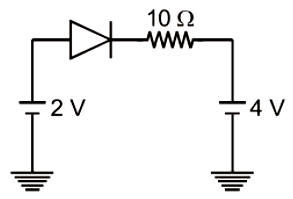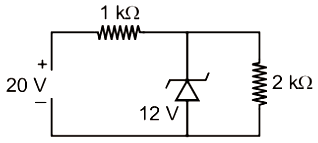1. \(n_i=n_e=n_h\)
2. \(n_i^2=n_en_h\)
3. \(n_h>> n_e\)
4. \(n_h<<n_e\)
The conductivity of an n-type semiconductor whose density of conduction electrons is , Density of holes is , Mobility of conduction electrons is and Mobility of holes is will be
1.
2.
3.
4.
The current through an ideal p-n junction diode shown in the circuit will be:

1. 5 A
2. 0.2 A
3. 0.6 A
4. zero
In a common-emitter transistor, the phase difference between input and output is:
1. Zero
2. /2
3. /3
4.


1. 36 mW
2. 12 mW
3. 144 mW
4. 64 mW
A semiconductor is known to have an electron concentration of \(8\times 10^{13}~\text{cm}^{-3},\) and a hole concentration of \(5\times 10^{2}~\text{cm}^{-3}.\) The semiconductor is:
| 1. | \(\mathrm{n}\text-\)type | 2. | \(\mathrm{p}\text-\)type |
| 3. | intrinsic | 4. | insulator |
In a common emitter transistor amplifier, the audio signal voltage across resistance of 1 k is 2V. If the base resistance is 200 and the current amplification factor is 50, the input signal voltage will be
1. 4 mV
2. 8 mV
3. 16 mV
4. 32 mV
The given electrical network is equivalent to
1. AND gate
2. OR gate
3. NOR gate
4. NOT gate
In a common-emitter transistor amplifier, the audio signal voltage across the collector is 3 V. The resistance of the collector is 3 k. If the current gain is 100 and the base resistance is 2 k, the voltage and power gain of the amplifier are:
1. 200 and 1000
2. 15 and 200
3. 150 and 15000
4. 20 and 2000
